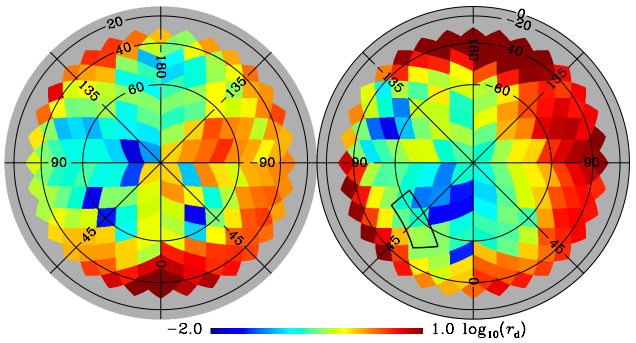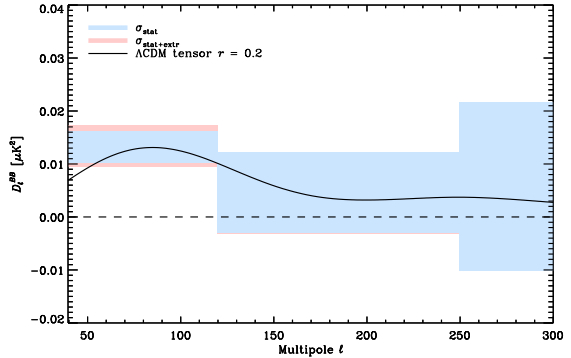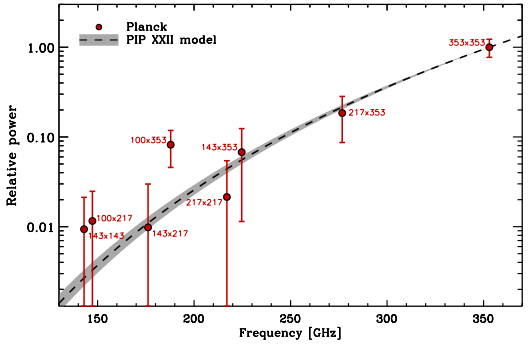Ever since we all heard the exciting news that the BICEP2 experiment had detected “B-mode” polarization in the cosmic microwave background — just the kind we would expect to be produced by cosmic inflation at a high energy scale — the scientific community has been waiting on pins and needles for some kind of independent confirmation, so that we could stop adding “if it holds up” every time we waxed enthusiastic about the result. And we all knew that there was just such an independent check looming, from the Planck satellite. The need for some kind of check became especially pressing when some cosmologists made a good case that the BICEP2 signal may very well have been dust in our galaxy, rather than gravitational waves from inflation (Mortonson and Seljak; Flauger, Hill, and Spergel).
Now some initial results from Planck are in … and it doesn’t look good for gravitational waves. (Warning: I am not a CMB experimentalist or data analyst, so take the below with a grain of salt, though I tried to stick close to the paper itself.)
Planck intermediate results. XXX. The angular power spectrum of polarized dust emission at intermediate and high Galactic latitudes
Planck Collaboration: R. Adam, et al.The polarized thermal emission from Galactic dust is the main foreground present in measurements of the polarization of the cosmic microwave background (CMB) at frequencies above 100GHz. We exploit the Planck HFI polarization data from 100 to 353GHz to measure the dust angular power spectra CEE,BBℓ over the range 40<ℓ<600. These will bring new insights into interstellar dust physics and a precise determination of the level of contamination for CMB polarization experiments. We show that statistical properties of the emission can be characterized over large fractions of the sky using Cℓ. For the dust, they are well described by power laws in ℓ with exponents αEE,BB=−2.42±0.02. The amplitudes of the polarization Cℓ vary with the average brightness in a way similar to the intensity ones. The dust polarization frequency dependence is consistent with modified blackbody emission with βd=1.59 and Td=19.6K. We find a systematic ratio between the amplitudes of the Galactic B- and E-modes of 0.5. We show that even in the faintest dust-emitting regions there are no "clean" windows where primordial CMB B-mode polarization could be measured without subtraction of dust emission. Finally, we investigate the level of dust polarization in the BICEP2 experiment field. Extrapolation of the Planck 353GHz data to 150GHz gives a dust power ℓ(ℓ+1)CBBℓ/(2π) of 1.32×10−2μK2CMB over the 40<ℓ<120 range; the statistical uncertainty is ±0.29 and there is an additional uncertainty (+0.28,-0.24) from the extrapolation, both in the same units. This is the same magnitude as reported by BICEP2 over this ℓ range, which highlights the need for assessment of the polarized dust signal. The present uncertainties will be reduced through an ongoing, joint analysis of the Planck and BICEP2 data sets.
We can unpack that a bit, but the upshot is pretty simple: Planck has observed the whole sky, including the BICEP2 region, although not in precisely the same wavelengths. With a bit of extrapolation, however, they can use their data to estimate how big a signal should be generated by dust in our galaxy. The result fits very well with what BICEP2 actually measured. It’s not completely definitive — the Planck paper stresses over and over the need to do more analysis, especially in collaboration with the BICEP2 team — but the simplest interpretation is that BICEP2’s B-modes were caused by local contamination, not by early-universe inflation.
Here’s the Planck sky, color-coded by amount of B-mode polarization generated by dust, with the BICEP2 field indicated at bottom left of the right-hand circle:
Every experiment is different, so the Planck team had to do some work to take their measurements and turn them into a prediction for what BICEP2 should have seen. Here is the sobering result, expressed (roughtly) as the expected amount of B-mode polarization as a function of angular size, with large angles on the left. (Really, the BB correlation function as a function of multipole moment.)
The light-blue rectangles are what Planck actually sees and attributes to dust. The black line is the theoretical prediction for what you would see from gravitational waves with the amplitude claimed by BICEP2. As you see, they match very well. That is: the BICEP2 signal is apparently well-explained by dust.
Of course, just because it could be dust doesn’t mean that it is. As one last check, the Planck team looked at how the amount of signal they saw varied as a function of the frequency of the microwaves they were observing. (BICEP2 was only able to observe at one frequency, 150 GHz.) Here’s the result, compared to a theoretical prediction for what dust should look like:
Again, the data seem to be lining right up with what you would expect from dust.
It’s not completely definitive — but it’s pretty powerful. BICEP2 did indeed observe the signal that they said they observed; but the smart money right now is betting that the signal didn’t come from the early universe. There’s still work to be done, and the universe has plenty of capacity for surprising us, but for the moment we can’t claim to have gathered information from quite as early in the history of the universe as we had hoped.



@JohnD
Other experiments that have been set up for finding gravitational waves measure the local speed of light to see if it varies. That is nothing more than a Michelson-Morley experiment that already failed to do this about 100 years ago and has been ever since. The fundamental basis for the Special Theory of Relativity heavily relies on the speed of light being an absolute constant in it’s derivation. Plus, no one ever proved that the force of gravity is limited by the speed of light, or that it even has a force carrier particle like the graviton. My spell checker still doesn’t even recognize that as being a real word!
Einstein even proved mathematically that if gravity was due to a force carrying particle that the number of them on any surface of a sphere would be infinite in one of his books on general relativity. No one ever seems to care about that! Then there is no reason why there should be this bias to gravity obeying a speed of light limit when quantum mechanical effects already violate that principal!
I think the lesson to be learned here is that, for the photon, the speed of light is a more deeply rooted to it than we think even though it doesn’t have to apply to every aspect of everything. If there is actually anything in the theory that says a Michelson-Morley experiment would be wrong, then the mathematics of gravitational waves needs to be corrected, because then it would clearly be in error!
It would make absolutely no sense at all to say that spacetime becomes dilated, because the speed of light is constant; just to turn around and say that the speed of light can be measured to be different in the presence of gravity even though this actually has never happened from any result of an experiment!
A lot of the discussion here is focused on the question of whether there is gravity wave signal in BICEP2 data, and indeed at the moment we cannot tell. However, what we can say with some confidence is the upper limit on it. Before BICEP2 the 95% upper limit on r was 0.13, after BICEP2 this became 0.11, and with the new Planck data this has improved to r<0.09 (see v2 of Mortonson and Seljak). phi^2 inflation is now excluded at nearly 3 sigma. It is unlikely that these conclusions will change when joint analysis of Planck and BICEP2 is finished, since even if something is seen it is unlikely it will be compatible with high values of r. Upper limits are less exciting that having a detection, but these results are having a real impact on testing and ruling out previously viable inflationary models.
Cheng, Huang and Wang got the new upper bound on r (r<0.083) in 1409.7025 before v2 of Mortonson and Seljak.
Sean,
Any thoughts on the recent Cortês, Liddle, and Parkinson that says (if I understand it correctly, which is a stretch) that even if the signal is not from dust, the types of waves are not what one would find in inflationary models?
http://arxiv.org/abs/1409.6530
Pingback: Morning Feature – Publish or Perish, Part II: Faster Than Light, Or Not | BPI Campus